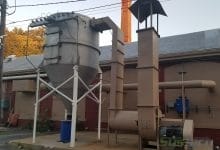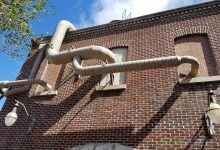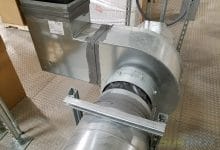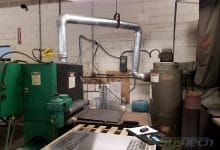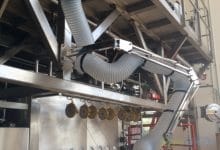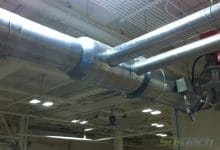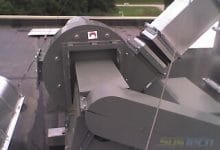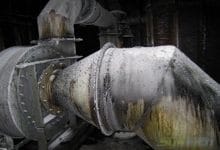Not again! How does this happen? Questions we ask when we see irregularities in industrial air systems in manufacturing plants and scratch our head while asking “how does this happen”? Often we supply ventilation equipment as part of a large duct system, but don’t get an opportunity to review the duct design/layout and the system does not perform as expected. The designer or plant engineer points the finger at our equipment!
As industrial ventilation specialists, we retrofit dust collection systems, many times on competitor equipment to resolve issues with collection and filtration of dust. A large part of the renovation always has at least one or two issues with the duct design or installed “add-on” duct laterals/drops to the dust collection system.
With staff reductions in engineering and maintenance, these duct and fitting design issues will come up. No bad guys here, just people trying to get the job done, working with monetary or equipment constraints and needing to move to the next assignment.
When we talk about industrial duct systems, we are talking about construction materials and fittings that are designed and rated for handling particulate or materials and high pressures, not low-pressure HVAC supply air designs.
Review these photos and see if you can identify potential problems:
What do we commonly see?
- A small lateral duct tapped into the side of the main large duct.
- Multiple duct laterals with “T” connections.
- Drops added to service new machines but without additional airflow or duct size redesign.
- Material build-up in the duct.
- Excessive lengths of flex hose in curled-up configurations.
- Disregard for resistance to airflow caused by abrupt changes in the direction of airflow.
- Hazardous duct configurations.
- Fans with wheels rotating in the wrong direction or labeled wrong.
- Inlet or outlet damper in wrong position and location.
- Sharp elbows at fan inlets or outlets.
- Fan discharge rotating opposite an outlet elbow discharge.
How does this happen? My guesses are:
- It is assumed that air can go anywhere and change direction easily.
- Clean HVAC airflow design is the same as industrial material laden airflow.
- The duct is just duct.
- No money is available to do it right.
- Quick fix needed.
- Misunderstanding of fluid flow. Air is a fluid and needs to be handled as such.
- Minimal industrial fabrication knowledge.
- Installation space envelope is very small.
- Manufacturing process limits access to the capture point.
- Reusing materials that are “in house”.
- Something is better than nothing.
- It is assumed that flex hose resistance to airflow is the same as a straight metal duct.
- Although knowledgeable in HVAC, installer not so in industrial duct systems.
- Project schedule too tight to change it.
- Not in the contractor’s contract.
That said, how is it possible that a small tweak to an existing duct system causes a problem? Well, because:
- Dust if it loses carry velocity, will settle in the duct system. Accumulated materials have weight and could cause the duct sections to separate or collapse.
- Accumulated combustible dust in the duct system is a fire and explosion hazard.
- Abrasive dust will wear out elbows and long sections very quickly if not designed with the right materials and will cause process shutdowns.
- Flex hose because of its design and how it is used, increases pressure drop and therefore airflow is reduced. A foot of extended flex hose can be equal to 5 feet of straight metal duct, and if coiled and bent, the loss is much greater.
- When pressure losses increase, CFM decreases, source capture is compromised, and particulate settles in the duct and horizontal surfaces. A serious explosion potential!
- Air takes the path of least resistance and will follow the closest path to an exhaust fan, resulting in unbalance to a duct system and inadequate airflow at critical locations.
- Fan performance ratings are a result of testing with straight duct inlets and outlets. Any change from that means delivering less airflow than designed.
- Over design or under design – wasted energy.
- OSHA and NFPA Standards ignored.
- Employee health issues – incomplete dust capture.
How to prevent this from happening? Maybe:
- Fans are the “heart” of a conveying system so make certain the inlet and outlet are as close to AMCA test conditions as possible to meet design airflow.
- Buy a copy of the Industrial Ventilation Manual. It’s a required read for industrial air system design.
- Commercial HVAC duct is not suitable for industrial applications.
- Select fabricator and installing contractor with proven industrial duct experience.
Points to remember about industrial duct:
- It’s designed for higher pressure (positive or negative) and materials in the airstream.
- It’s configured with fittings that minimize pressure loses in the system. Example – long radius elbows and entry configurations to allow “smooth” airflow.
- It has properties to protect against abrasion.
If your system performance is not what you need, don’t blame the fan, source capture hood or the dust collector before you investigate the duct and be certain it was designed correctly up front or fix it right!
At SysTech we have the application experience and have worked through and corrected many duct system dysfunctions. We are here to be a resource and make it right; it’s what we do. If you have applications that are suffering from any of the above, we can do system reviews and make suggestions that will meet your expectations. Reach out to us at 800-456-9460 for more information.

